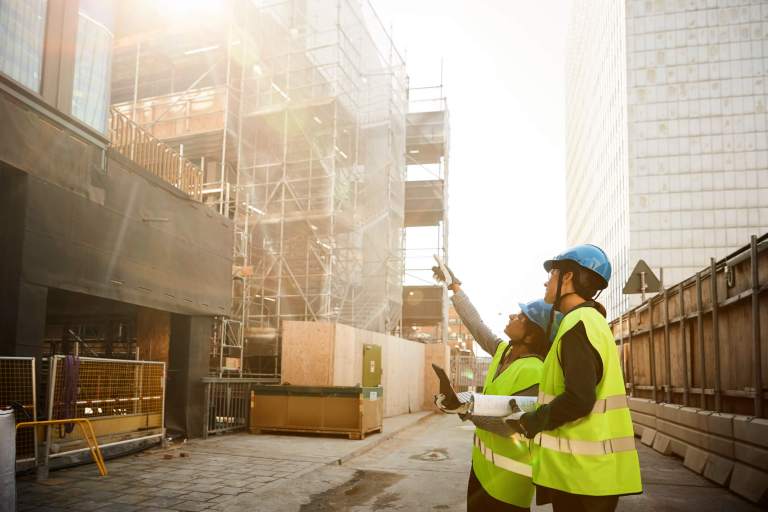According to UN Global Compact, an estimated 2.78 million workers lose their lives in work-related accidents and illnesses each year, while 374 million more suffer from non-fatal workplace accidents. This indicates that about 2 million people lose their lives to work-related causes every year. Therefore, now more than ever there is a need for safety innovations that will improve the health and safety of workers.
In fact, the need for safety solutions that reduce hazards and improve operational efficiency is only going to increase as industries change. In the manufacturing, construction, energy, and other industrial sectors, recent years have brought about revolutionary advances aimed at establishing safer working conditions. Some of the new safety technologies and solutions that have been developed can help reduce workplace fatalities and injuries. Have a look at the most revolutionary safety technologies of the year and their potential to change the way we work.
1. AI-Powered Safety Monitoring
Artificial intelligence (AI) has become an integral tool in safety management. Currently, AI-driven systems are capable of real-time hazard detection and response. These solutions use machine learning algorithms to analyse video feeds, identifying unsafe practices, such as workers not wearing protective gear or being in restricted zones.
Key Examples:
- Smart cameras: equipped with AI to detect potential accidents and alert supervisors instantly.
- Behavioral analytics: AI tools that predict risks based on worker movement patterns, significantly reducing workplace injuries.
2. Wearable Safety Technology
Wearable devices have reached new heights in functionality and design. From smart helmets to bio-monitoring wearables, these devices are equipped with sensors to provide real-time health data and environmental alerts.
Key Features:
- Exoskeletons: supporting workers in physically demanding tasks while reducing strain-related injuries.
- Smart glasses: enhancing situational awareness by overlaying safety alerts and instructions in the user’s field of view.
- Bio-sensing wearables: tracking vital signs such as heart rate, temperature, and fatigue levels to prevent accidents caused by overexertion.
3. Advanced Robotics for Hazardous Tasks
Robots are increasingly being deployed in high-risk environments, minimising human exposure to potential dangers. Robotic arms or collaborative robots help industrial workers in dangerous tasks, such as handling heavy loads, high-speed welding, and robotic assembly.
Notable Developments:
- Inspection drones: used in confined spaces or at heights, drones can safely inspect structures like bridges or pipelines.
- Collaborative robots (Cobots) designed to work alongside humans, cobots handle repetitive or dangerous tasks, reducing injury risks while improving productivity.
4. Enhanced Emergency Response Systems
With the use of IoT and real-time analytics, emergency response solutions have advanced in speed and intelligence, identifying threats, sending automated alerts, and directing prompt, well-informed actions. This integration lowers risks, speeds up response times, and improves coordination.
Highlights:
- IoT-connected safety devices: fire alarms, gas detectors, and emergency stop buttons now communicate with centralised systems to provide comprehensive insights during crises.
- Augmented Reality (AR) training: AR platforms enable workers to practice emergency protocols in realistic, simulated environments.
5. Sustainable Safety Solutions
As businesses prioritise environmentally friendly solutions that support their ESG (Environmental, Social, and Governance) objectives, sustainability is having an increasing impact on safety innovations. Companies are incorporating sustainable practices into their safety procedures in an effort to lessen their impact on the environment while upholding strict worker protection regulations. This change helps companies comply with legal requirements, improve their standing with stakeholders that care about the environment, and promote global sustainability initiatives.
Examples:
- Recyclable PPE: protective equipment made from sustainable materials to reduce waste.
- Solar-powered safety lights: ideal for construction sites or remote locations with limited access to traditional power sources.
6. Predictive Maintenance for Safety
Predictive maintenance tools, powered by AI and IoT, ensure equipment operates safely. These technologies monitor machinery for early signs of wear and tear, preventing failures that could lead to accidents. These innovative methods regularly check on machines, evaluating data to find possible problems like misalignment or wear and tear early on. Predictive maintenance helps avoid unforeseen malfunctions that can result in mishaps, lost productivity, or expensive repairs by seeing issues before they become serious. This proactive strategy prolongs the life of vital equipment, increases operational reliability, and improves worker safety.
Popular Solutions:
- Vibration sensors: detecting anomalies in rotating machinery.
- Thermal imaging cameras: identifying overheating equipment before it becomes hazardous.
7. Cybersecurity in Safety Systems
As safety technologies rely more on connected systems, ensuring their cybersecurity is paramount. Robust cybersecurity measures are being integrated to protect critical safety infrastructures from malicious attacks. Some of the cyber threads in factories, such as viruses, ransomware attacks or data breaches, can lead to serious consequences for the safety of people and the environment.
Cyber Safety Solutions:
- Zero trust architecture: a security model that assumes no entity, internal or external, can be trusted by default. This approach requires verification of every user and device accessing a system, significantly reducing the risk of breaches.
- Endpoint protection: advanced software safeguards devices like sensors, PLCs, and controllers from being exploited as entry points for attackers.
Conclusion
The safety innovations of recent years represent a fusion of cutting-edge technology and proactive risk management. Industries that embrace these advancements are not only prioritising worker safety but also boosting operational efficiency and sustainability. As these technologies continue to evolve, the future looks promising for safer workplaces worldwide.
The aforementioned guidelines do not guarantee the safety of people and the environment. For specific requirements, consult with your safety managers and/or regulatory bodies.











